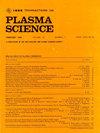On Axial Current Induction and Stability of a Pinch
IF 1.5
4区 物理与天体物理
Q3 PHYSICS, FLUIDS & PLASMAS
引用次数: 0
Abstract
We present an approach for the induction of the plasma axial current in a pinching device, that consists in the use of apertures in the external tubular conductor that surrounds the plasma itself. These apertures are spaced at regular intervals along the axis of the device and a radial parallel plate waveguide is coupled to each of them. To the end of each waveguide, a time-varying power source is connected and operated synchronously with all the others. We analyze the stability of the plasma motion in this device by using a model, the ideal device, in which the actual electromagnetic field is approximated by that generated by a time-varying azimuthal current distributed on the internal surface of the external conductor and a time-varying axial current flowing on the surface of the plasma. The desired or reference plasma motion inside the ideal device is a sequence of cylindrical equilibrium configurations coaxial with the external conductor that extends indefinitely. We analyze the stability of a reference trajectory, along which the plasma is compressed and expanded under the action of a screw magnetic field, by using a simplified set of linear equations of motion, based on the quasi 1-D flow of a gas, with electromagnetic forces complying with the quasi static approximation. Under the hypothesis that the azimuthal and axial currents are not perturbed, we show that an axial magnetic flux frozen in the plasma and an external conductor are necessary for stability. We also show that an axial magnetic field external to the plasma is not necessary for stability, so that, in a real device, its role could be limited to that of replenishing the embedded one, while the plasma is in contact or nearly in contact with the wall of its container. As opposed to previous theoretical investigations, we do not use the energy principle to prove stability/instability of a steady-state pinch without computing the eigenvalues of the linear equations of motion. On the contrary, for the cylindrical configuration analyzed, after decomposing the plasma motion in its main components, that is, massless, fluid, and string modes (the sausage and kink modes in previous different models), we compute the generalized masses and stiffnesses of the fluid and string modes. In the steady-state case, this allows us to compute their eigenvalues as a function of the geometric and magnetic parameters and then ascertain stability or instability of a specific pinch. By using these expressions, we also formulate necessary and/or sufficient conditions for stability, on the basis of which we are able to show the consistency of our results with the ones obtained in previous investigations. In particular, we derive a sufficient stability condition which is similar to the Kruskal-Shafronov necessary stability condition. We also formulate stability conditions in the time-varying case, which seems to be a novelty, except for what was done by this author in a recently published paper.论轴向电流感应和夹持稳定性
我们提出了一种在夹持装置中诱导等离子体轴向电流的方法,即在环绕等离子体的外部管状导体上开孔。这些开孔沿设备轴线以一定间隔分布,每个开孔上都有一个径向平行板波导。每个波导的末端都连接了一个时变电源,并与其他所有波导同步运行。我们使用一个理想设备模型来分析该设备中等离子体运动的稳定性,在该模型中,实际电磁场近似于由分布在外部导体内表面上的时变方位电流和等离子体表面上的时变轴向电流所产生的电磁场。理想设备内部的理想或参考等离子体运动是一连串与外部导体同轴的圆柱形平衡构型,并无限延伸。我们使用一套简化的线性运动方程,以准一维气体流为基础,利用符合准静态近似的电磁力,分析了参考轨迹的稳定性。在方位和轴向电流不受扰动的假设下,我们证明了冻结在等离子体中的轴向磁通和外部导体是稳定的必要条件。我们还证明,等离子体外部的轴向磁场不是稳定的必要条件,因此在实际设备中,当等离子体与容器壁接触或几乎接触时,轴向磁场的作用仅限于补充嵌入的磁场。与以往的理论研究不同,我们不使用能量原理来证明稳态夹持的稳定性/不稳定性,而不计算线性运动方程的特征值。相反,对于所分析的圆柱形构型,在将等离子体运动分解为其主要组成部分,即无质量模式、流体模式和弦模式(以前不同模型中的香肠模式和扭结模式)之后,我们计算了流体模式和弦模式的广义质量和刚度。在稳态情况下,我们可以计算出它们的特征值与几何参数和磁参数的函数关系,从而确定特定捏合的稳定性或不稳定性。通过使用这些表达式,我们还提出了稳定性的必要和/或充分条件,在此基础上,我们能够证明我们的结果与之前研究中获得的结果是一致的。特别是,我们推导出了与 Kruskal-Shafronov 必要稳定性条件相似的充分稳定性条件。我们还提出了时变情况下的稳定性条件,这似乎是一个新颖之处,除了作者在最近发表的一篇论文中所做的之外。
本文章由计算机程序翻译,如有差异,请以英文原文为准。
求助全文
约1分钟内获得全文
求助全文
来源期刊

IEEE Transactions on Plasma Science
物理-物理:流体与等离子体
CiteScore
3.00
自引率
20.00%
发文量
538
审稿时长
3.8 months
期刊介绍:
The scope covers all aspects of the theory and application of plasma science. It includes the following areas: magnetohydrodynamics; thermionics and plasma diodes; basic plasma phenomena; gaseous electronics; microwave/plasma interaction; electron, ion, and plasma sources; space plasmas; intense electron and ion beams; laser-plasma interactions; plasma diagnostics; plasma chemistry and processing; solid-state plasmas; plasma heating; plasma for controlled fusion research; high energy density plasmas; industrial/commercial applications of plasma physics; plasma waves and instabilities; and high power microwave and submillimeter wave generation.
 求助内容:
求助内容: 应助结果提醒方式:
应助结果提醒方式:


